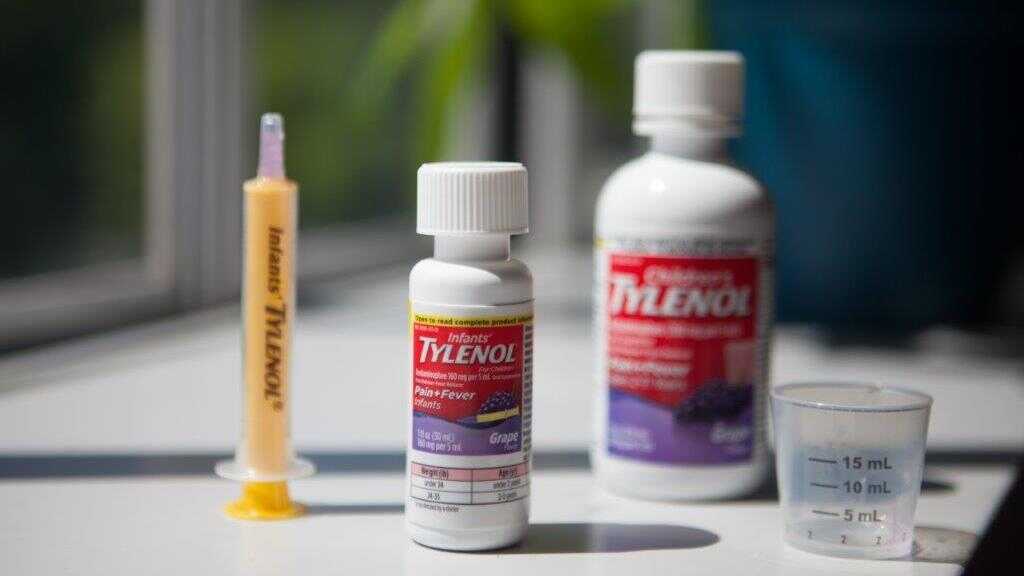How Much Tylenol to Give My 10 Month Old

Infants' Tylenol comes with a dosing syringe, while Children's Tylenol has a plastic cup. Both contain the same concentration of the active ingredient, acetaminophen. Ryan Kellman/NPR hide caption
toggle caption
Ryan Kellman/NPR

Infants' Tylenol comes with a dosing syringe, while Children's Tylenol has a plastic cup. Both contain the same concentration of the active ingredient, acetaminophen.
Ryan Kellman/NPR
If you've ever had a little one at home with a fever, you might have noticed two options for Tylenol at the store.
There's one for infants and one for children. They contain the same amount of medicine — 160 milligrams of acetaminophen per 5 milliliters of liquid — but the infant version costs three times more.
What gives? It turns out, there's a backstory.
For decades, Infants' Tylenol was stronger than the children's version. The thinking was that you don't want to give babies lots of liquid medicine to bring down a fever — so you can give them less if it's stronger.
"It was three times more concentrated," says Inma Hernandez of the University of Pittsburgh School of Pharmacy. Since it contained more acetaminophen, the active ingredient, she says, it made sense that it was also more expensive. "The price per milliliter was five times higher," Hernandez says.
But there was a problem: Parents were making mistakes with dosing. Babies got sick — some even died. So in 2011, at the urging of the Food and Drug Administration, the maker of brand-name Tylenol, Johnson & Johnson, announced a change: Infants' Tylenol would be the same concentration as Children's Tylenol.
Now it's the same medicine, but the price is still different.
A quick search online shows 4 ounces of Children's Tylenol selling for $5.99, and Infants' Tylenol also selling for $5.99, but for only 1 ounce of medicine. With many store brands of acetaminophen, it's the same story: The infant version is generally three times more expensive than the one for children.
Kim Montagnino of Johnson & Johnson said in a statement to NPR that Infants' Tylenol is more expensive because the bottle is more sturdy and it includes a dosing syringe, instead of a plastic cup. "These safety features of Infants' Tylenol (dosing syringe, rigid bottle) are more expensive to manufacture than the dosing cup and bottle for Children's Tylenol," Montagnino wrote.
Hernandez doesn't buy it.
"The cup versus the syringe doesn't really explain the price difference in my opinion," Hernandez says. "They're really cheap because they're just plastic. When we think of what's expensive in a drug, it's actually the active ingredient, and the preparation of that active ingredient in the formulation, not the plastic cup or the syringe."
But Johnson & Johnson's explanation makes sense to Edgar Dworsky, a consumer advocate and founder of the website Consumer World. "There's an extra thing in the box, and extra things usually cost money," he says.
"Think of a spray cleaner. You can buy the spray cleaner in the spray bottle, and that costs a little more money. Or you can buy the refill that gives you more ounces but it doesn't have the sprayer on top — it's kind of the same concept."
But this, of course, is not a spray cleaner. It's medicine. And parents are sensitive to marketing because the stakes are so high.
"I would certainly imagine that product-makers know that parents want to be very cautious when buying products for their kids," Dworsky says. "Really, the lesson is — read the label. See what you're getting for your money."
Pediatrician Ankoor Shah at Children's National Health System in Washington, D.C., knows how confusing all of this is for parents because he gets tons of questions from them about over-the-counter medications.
"The packaging and the dosing is not easy, it's not simple and — personal opinion — it's not parent-friendly," Shah says.
For instance, Infants' Tylenol doesn't say on the label what the correct dosing is for a baby under age 2. It just says "ask a doctor." Shah says he still uses a calculator to figure out how much to give a child, based on their weight, and gives slips to parents at kids' well visits. You can also find the information from reputable sources online.
He says whether you opt for the Children's or Infants' bottle of acetaminophen at the store, the most important thing is to get the dosing right.
"When you start giving more acetaminophen than recommended, there are serious side effects that could happen," he says.
The bottom line is: Know what you need. And if you need to spend that extra couple of dollars for the syringe and the special bottle to get the dosing just right, maybe the markup is worth it.
If you think you might have inadvertently overdosed a child, contact your doctor or call your local poison control center . There are 55 poison control centers across the U.S.; all of them can be reached at the same hotline number: 1-800-222-1222 .
How Much Tylenol to Give My 10 Month Old
Source: https://www.npr.org/sections/health-shots/2019/05/27/726327937/tylenol-for-infants-and-children-is-the-same-why-does-1-cost-3-times-more